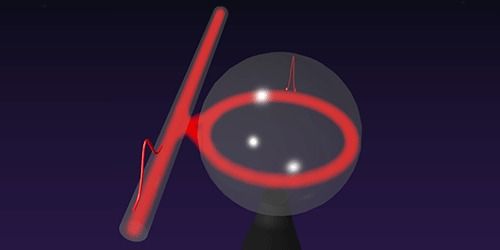During suicide bombings.
Scientists at the University of Lund in Sweden have found a way to use “biological motors” for parallel computing. The findings could mean vastly more powerful and energy efficient computers in a decade’s time.
Nanotechnologists at Lund University in Sweden have discovered a way to miniaturize the processing power that is found today only in the largest and most unwieldy of supercomputers. Their findings, which were published in the Proceedings of the National Academy of Sciences, point the way to a future when our laptops and other personal, handheld computing devices pack the computational heft of a Cray Titan or IBM Blue Gene/Q.
But the solution may be a little surprising.
Back in 2014, we told you about Rise, a film about a robot insurgency that was the subject of a Kickstarter campaign. The result of the $38,000 raised is this proof of concept video, which definitely looks good enough to deserve a full feature.
Rise comes from director David Karlak and writers Marcus Dunstan and Patrick Melton (Feast). It’s one of those classic robot revolution stories. Of course, in this case you find yourself in the awkward position of rooting for the failure of humans, but that’s sometimes how these things shake out. Plus, it’s always easier to side with Anton Yelchin than Rufus Sewell.
This is clearly a pitch for some studio to give them money to make a full thing, and it’s one of the most successful of that genre I’ve ever seen. There’s clearly a story in mind and Karlak’s vision looks great in these five minutes.
Back in January, the astronomer who led the charge to have Pluto demoted to dwarf planet status announced that he’d just found evidence that a huge, icy planet could be lurking on the edge of the Solar System, just past Neptune.
Mike Brown, a planetary astronomer at Caltech University, estimated that the hypothetical ‘Planet Nine’ appears to be circling the Sun on a super-elongated orbit that takes an incredible 10,000 to 20,000 years to complete. And now, thanks to a newly detected Kuiper Belt Object (KBO) that’s acting really strange, Brown says the case for Planet Nine just got a whole lot stronger.
“Hey Planet Nine fans, a new eccentric KBO was discovered. And it is exactly where Planet Nine says it should be,” Brown tweeted over the weekend.
Dark matter is one of the greatest revelations in modern physics. Even though it hasn’t been directly detected yet, we know that it makes up around five-sixths of the total matter in the universe, binding much of it together in dramatic ways. It is this matter that stops galaxies from being torn apart as they spin.
As a new study published in the journal Physics of the Dark Universe notes, dark matter can also be destroyed. A signature of dark matter’s annihilation could potentially reveal what it was composed of in the first place, and this team of researchers from Harvard University think they’ve found one right in the heart of our own Milky Way.
Scientists are still debating what dark matter may actually be composed of, and one recent suggestion implies the particles are so dense that they are on the verge of becoming miniature black holes. Whatever they turn out to be, many astrophysicists think that these particles share a property with “ordinary” matter: they come in two flavors, matter and antimatter. When matter encounters antimatter, both are destroyed in a powerful blast that emits high-energy radiation.
Synopsis: Photon’s Lifetime Extended
Posted in physics
My new article for TechCrunch on capitalism and the robot revolution:
Economic experts are trying to figure out a question that just two decades ago seemed ridiculous: If 90 percent of human jobs are replaced by robots in the next 50 years — something now considered plausible — is capitalism still the ideal economic system to champion? No one is certain about the answer, but the question is making everyone nervous — and forcing people to dig deep inside themselves to discover the kind of future they want.
After America beat Russia in the Cold War, most of the world generally considered capitalism to be the hands-down best system on which to base economies and democracies. For decades, few doubted capitalism’s merit, which was made stronger by thriving globalization and a skyrocketing world net worth. In 1989 — when the Berlin Wall fell — the world had only 198 billionaires. Now, according to Forbes, there are 1,826 of them in 2016.
Despite growing riches, when banks collapsed in 2007 during the Great Recession, the world stepped back and wondered aloud if a more nuanced approach to economic progress was needed. These doubts of 21st century capitalism helped set the stage for an economic paradigm shift just starting to appear — economists observing jobs not just disappearing to other countries, but disappearing off the face of the Earth. The culprit: robots and software.
Astronomers have captured video evidence of a collision between Jupiter and a small celestial object, likely a comet or asteroid. Though it looks like a small blip of light, the resulting explosion was unusually powerful.
As Phil Plait of Bad Astronomy reports, the collision occurred on March 17, but confirmation of the event only emerged this week. An amateur Austrian astronomer used a 20-centimeter telescope to chronicle the unexpected event, but it could’ve been some kind of visual artifact.
Oh, joy. I hope it doesn’t take an actual catastrophe before the world comes together to get all of our eggs out of this one basket.
Comet P/2016 BA14 was initially thought to be a cosmic lightweight, but as it flew past Earth on March 22, NASA pinged it with radar to reveal just what a heavyweight it really is.
Synthetic biology involves creating or re-engineering microbes or other organisms to perform specific tasks, like fighting obesity, monitoring chemical threats or creating biofuels. Essentially, biologists program single-celled organisms like bacteria and yeast much the same way one would program and control a robot.
But 10 years ago, it was extremely challenging to take a DNA sequence designed on a computer and turn it into a polymer that could implement its task in a specific host, say a mouse or human cell. Now, thanks to a multitude of innovations across computing, engineering, biology and other fields, researchers can type out any DNA sequence they want, email it to a synthesis company, and receive their completed DNA construct in a week. You can build entire chromosomes and entire genomes of bacteria in this way.
“Biology is the most powerful substrate for engineering that we know of,” said Christopher Voigt, Professor of Biological Engineering at MIT. “It’s more powerful than electrical engineering, mechanical engineering, materials science and others. Unlike all the other fields, we can look at what biology is already able to do. When we look at the natural world, we see things like the brain. That’s a complex place computing, electrical engineering and computer science can’t reach. The brain even constructs nanostructures very deliberately, something materials science has not accomplished.”








